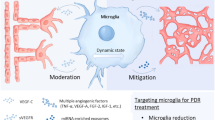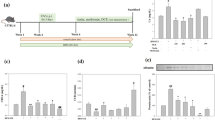Abstract
Introduction
To investigate the protect effect of polysaccharides extract from cassia seeds (CSPE) on human retinal endothelial cells (HRECs) in hyperglycemia environment.
Methods
The same amount of human retinal endothelial cells (HRECs), respectively, inoculated in vitro were divided into normal group (Con group), hyperglycemia group (H-Glu group), and different concentration of cassia polysaccharides extract (CSPE) combined with high glucose medium group (CSPE group). HRECs in Con group were cultured routinely. The cell in H-Glu group was treated with high glucose, in which the concentration of glucose in the medium was 30 mM. HRECs in CSPE group were treated with different concentrations of CSPE combined with high glucose. Enhanced cell counting kit-8(CCK8) assay was used to measure the HRECs cell survival rate in different groups. The generation of reactive oxygen species (ROS) in different group was measured by flow cytometry. The real-time quantitative PCR analysis was used for determining intracellular heme oxygenase-1 (HO-1) mRNA levels. Western Blot was applied to test the change of proteins, such as HO-1- and NF–E2-related factor 2 (Nrf2) protein.
Results
The cell survival rate of the H-Glu group was significantly lower than that of the Con group (P < 0.05). When the concentration of CSPE was 100 mg/ml in CSPE group, the HRECs cell survival rate was significantly lower than that of the Con group (P < 0.05), and there was no significant difference with H-Glu group. When the concentration of CSPE in CSPE group was between 50 µg/ml and 1 × 104 µg/ml, the survival rate of HRECs cells showed no significant difference compared with that of H-Glu group and Con group. However, when the concentration of CSPE in CSPE group was between 2.5 and 40 µg/ml, the HRECs cell survival rate was significantly higher than that of H-Glu group (P < 0.05) with a concentration-independent, and there was no significant difference between CSPE group and Con group. The ROS production was lowest in the CSPE group and was lower in Con group than in the H-Glu group. The contents of HO-1 mRNA (P < 0.05), HO-1 and Nrf2 protein were lower in the H-Glu group than in the CSPE and Con group, and there was no significant difference between the CSPE group and H-Glu group.
Conclusions
A certain concentration range of CSPE can increase the expression of the downstream protein HO-1 and negatively regulate the production of ROS by upregulating the expression of Nrf2, thus protecting human retinal endothelial cells from oxidative damage caused by high glucose.





Similar content being viewed by others
Data Availability
The data used to support the findings of this study are included within the article.
References
Kowluru RA, Kowluru A, Mishra M, Kumar B (2015) Oxidative stress and epigenetic modifications in the pathogenesis of diabetic retinopathy. Prog Retin Eye Res 48:40–61
Shrestha S, Seong SH, Paudel P, Jung HA, Choi JS (2017) Structure related inhibition of enzyme systems in cholinesterases and BACE1 in vitro by naturally occurring naphthopyrone and its glycosides isolated from Cassia obtusifolia. Molecules 23(1):69–85
Wang LF, Yan ZY, Li YL, Wang YH, Zhang SJ, Jia X et al (2019) Inhibition of Obtusifolin on retinal pigment epithelial cell growth under hypoxia. Int J Ophthalmol 12(10):1539–1547
Huang Y-L, Chow C-J, Tsai Y-H (2012) Composition, characteristics, and in-vitro physiological effects of the water-soluble polysaccharides from Cassia seed. Food Chem 134(4):1967–1972
Kowluru RA, Kennedy A (2001) Therapeutic potential of anti-oxidants and diabetic retinopathy. Expert Opin Investig Drugs 10(9):1665–1676
Liu C, Liu Q, Sun J, Jiang B, Yan J (2014) Extraction of water-soluble polysaccharide and the antioxidant activity from Semen cassiae. J Food Drug Anal 22(4):492–499
Vakifahmetoglu-Norberg H, Ouchida AT, Norberg E (2017) The role of mitochondria in metabolism and cell death. Biochem Biophys Res Commun 482(3):426–431
Kowluru RA, Mishra M (2015) Oxidative stress, mitochondrial damage and diabetic retinopathy. Biochem Biophys Acta 1852(11):2474–2483
Wang Q, Zhou J, Xiang Z, Tong Q, Pan J, Wan L et al (2019) Anti-diabetic and renoprotective effects of Cassiae Semen extract in the streptozotocin-induced diabetic rats. J Ethnopharmacol 239:111904
Feng L, Yin JY, Nie SP, Wan YQ, Xie MY (2018) Enzymatic purification and structure characterization of glucuronoxylan from water extract of Cassia obtusifolia seeds. Int J Biol Macromol 107(Pt B):1438–1446
Fan J, Xu G, Fau-Jiang T, Jiang T, Fau-Qin Y (2012) Qin Y (2012) Pharmacologic induction of heme oxygenase-1 plays a protective role in diabetic retinopathy in rats. Investig Ophthalmol Vis Sci. 53:6541–6556 (1552–5783 (Electronic))
Rubio-Navarro A, Vazquez-Carballo C, Guerrero-Hue M, Garcia-Caballero C, Herencia C, Gutierrez E et al (2019) Nrf2 plays a protective role against intravascular hemolysis-mediated acute kidney injury. Front Pharmacol 10:740
Di Marco E, Jha JC, Sharma A, Wilkinson-Berka JL, Jandeleit-Dahm KA, de Haan JB (2015) Are reactive oxygen species still the basis for diabetic complications? Clin Sci 129:199–216 (1470-8736 (Electronic))
Zhong Q, Mishra M, Kowluru RA (2013) Transcription factor Nrf2-mediated antioxidant defense system in the development of diabetic retinopathy. Invest Ophthalmol Vis Sci 54(6):3941–3948
Guo D, Yu K, Sun XY, Ouyang JM (2018) Structural characterization and repair mechanism of gracilaria lemaneiformis sulfated polysaccharides of different molecular weights on damaged renal epithelial cells. Oxid Med Cell Longev 2018:7410389
Zhang T, Mei X, Ouyang H, Lu B, Yu Z, Wang Z et al (2019) Natural flavonoid galangin alleviates microglia-trigged blood-retinal barrier dysfunction during the development of diabetic retinopathy. J Nutr Biochem 65:1–14
Fan J, Xu G, Jiang T, Qin Y (2012) Pharmacologic induction of heme oxygenase-1 plays a protective role in diabetic retinopathy in rats. Invest Ophthalmol Vis Sci 53(10):6541–6556
Mishra M, Zhong Q, Kowluru RA (2014) Epigenetic modifications of Nrf2-mediated glutamate-cysteine ligase: implications for the development of diabetic retinopathy and the metabolic memory phenomenon associated with its continued progression. Free Radical Biol Med 75:129–139
Feng L, Yin J, Nie S, Wan Y, Xie M (2016) Fractionation, physicochemical property and immunological activity of polysaccharides from Cassia obtusifolia. Int J Biol Macromol 91:946–953
Funding
This research is funded by the fund of Jinhua science and technology bureau (2015–3-01, 2018–3-019) and the general scientific research project fund of Zhejiang provincial department of education (Y201941633).
Author information
Authors and Affiliations
Contributions
ZL gave a starting point for the direction of the project. NH gave advice for writing this paper. MS was a major contributor in writing the manuscript and doing the experiments. We would like to thank Dr. Wenxia Xu and Ms. Xiaoya Zhao for their assistance in the laboratory platform and experimental guidance. All authors contributed to drafting the article and revising it critically for important intellectual content and final approval of the version to be published.
Corresponding author
Ethics declarations
Conflict of Interest
The authors have no conflicts of interest to declare.
Ethical Approval
Not applicable.
Additional information
Publisher's Note
Springer Nature remains neutral with regard to jurisdictional claims in published maps and institutional affiliations.
Supplementary Information
Below is the link to the electronic supplementary material.
Rights and permissions
About this article
Cite this article
Sun, M., He, N. & Lv, Z. Polysaccharides extracted from Cassia seeds protect against high glucose-induced retinal endothelial cell injury. Int Ophthalmol 41, 2465–2472 (2021). https://doi.org/10.1007/s10792-021-01801-5
Received:
Accepted:
Published:
Issue Date:
DOI: https://doi.org/10.1007/s10792-021-01801-5




